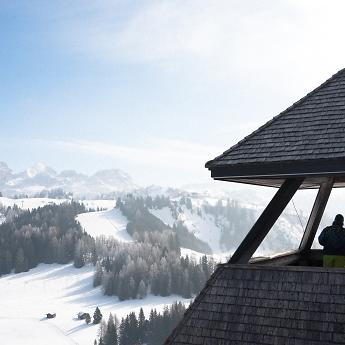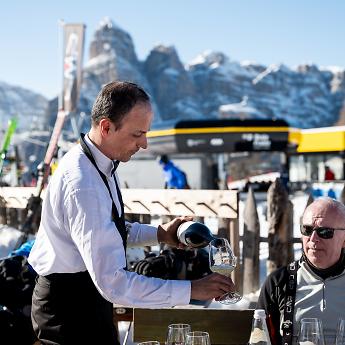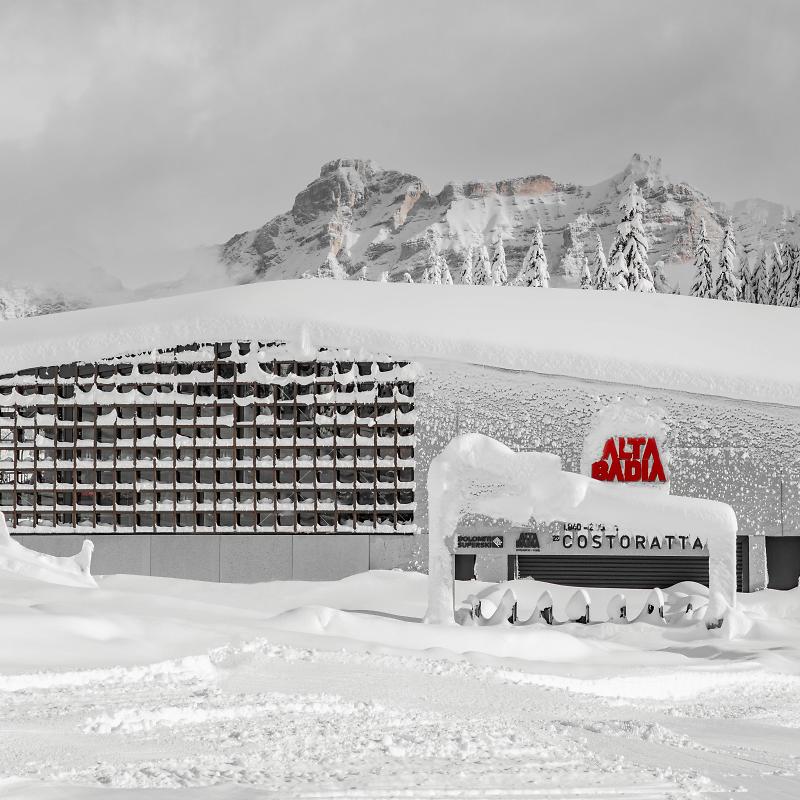
Tradition and Innovation
How contemporary architecture redefines Alta Badia
South Tyrol has established itself as a reference point for contemporary Italian architecture – a region where thoughtful local policies have built a strong architectural identity over the years, finding its most authentic expression in the built environment. This distinctive character emerges from a particular approach to design, where tradition and modernity have learned to engage in meaningful dialogue, generating practices and sensibilities that are entirely local.
Within this established context, Alta Badia represents a compelling place where contemporary architecture faces the challenges of a landscape that makes no compromises. Here, designing means finding the balance between respect for ancient traditions and adapting to the pressures of an evolving tourism industry, turning morphological and cultural constraints into creative possibilities: an art of working with what exists, where necessity becomes virtue and each new project offers a chance to redefine the relationship between buildings and landscape.
The dialogue with Birgit Kostner (Kostner Architects), Daniel Tolpeit and Jan Marc Castlunger (Castlungerhomes), and Emanuel Kostner (Studio Kostner) reveal several fascinating aspects of Alta Badia's contemporary architecture.
Negotiating topography
The landscape in Alta Badia tells, through its built forms, a long story of adaptation and dialogue with an environment that has always demanded ingenious solutions. The ancient viles – those agricultural settlements that still dot the valley today – emerged from the need to live in harmony with a place where every square metre had to be earned and every built element served a precise purpose, never merely decorative.
Today, that same adaptive capacity takes new forms through an approach that has transformed limitations into design resources. "By now, all the easy, flat building sites have been developed," explains Birgit from Kostner Architects, capturing one of the main challenges facing anyone designing in the valley today. "In almost all our projects we find ourselves working on slopes, in more difficult and complex situations; and most of the time, we talk with the builders directly on site," she continues, describing a working method that has made controlled improvisation a design tool, where solutions emerge from direct collaboration between different skills.
Emanuel Kostner from Studio Kostner adds to this reflection the temporal dimension that makes everything even more complex: in structures destined for tourist accommodation, work must be concentrated in time windows of three, at most four months, when the valley is not frequented by visitors. This complexity is reflected in the design process and also in the organization of construction sites themselves, where the restricted timelines imposed by tourist seasons require precise and careful planning.
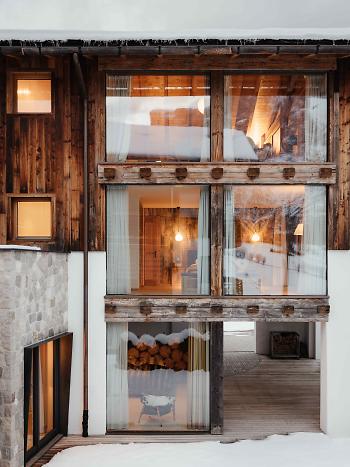
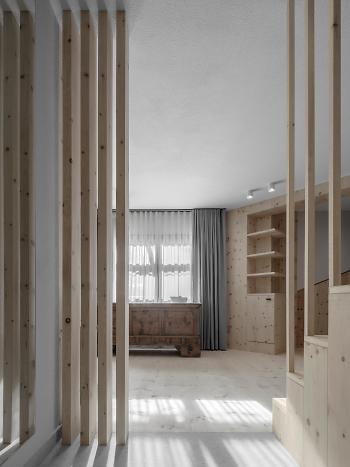
Transcending the tourist gaze
The risk of working in a territory so defined by its landscape and cultural character lies in succumbing to that comforting image that often shapes how visitors perceive these places. Yet it is crucial to move beyond this reassuring but limiting perspective, because mountains are by their very nature in constant flux, carrying change in their DNA. Moving beyond this constraining view means recognising that mountains embody transformation: embracing this evolution through an architectural lens offers a real opportunity to enhance the context, too often reduced to mere scenic backdrop.
"Our aim isn't to replicate something that already exists, but to carry forward a contemporary interpretation of local architecture," explain the team at Castlungerhomes. This position finds its most effective expression in a principle as simple as it is profound: "Ladin architecture doesn't live through copies, but through authenticity." A principle that recovers not so much the form as the spirit of a tradition capable of responding to present needs with logical and fitting solutions.
Emanuel Kostner frames the issue within a broader perspective: "The valley has undergone a radical transformation, moving from an agricultural economy to an international destination." In the 1980s and 1990s, this shift often produced buildings that were "out of scale" and failed to engage with the existing landscape. Today, the work of younger practitioners aims for better integration of new interventions within the territory, proposing more nuanced volumes that sit harmoniously within their context.
Engaging local making
Another way of listening to and valuing memory and tradition has been through the evolving relationship with local craftsmanship. This isn't a choice driven by nostalgia, but a deliberate strategy that allows traditional techniques and materials to be reinterpreted in contemporary ways.
"Materials are definitely one area where we engage deeply with tradition," observes Birgit with the pragmatism of someone who knows that every project comes down to concrete choices. Wood from local forests, lime renders, processing techniques passed down through generations—these become the vocabulary for writing new architectures. Local craftsmen are brought in for their ability to work these materials with skill and expertise, keeping alive knowledge that might otherwise be lost.
The Ciamplò project by Kostner Architects perfectly illustrates this approach. "It's a real example of local craftsmanship in action. The client produced timber, we worked with all the local firms, and the collaboration was excellent," Birgit recounts. Hand-made tiles, exposed concrete crafted by local workers: the result shows how the partnership between designer and craftsman creates a quality of construction that only passion and local knowledge can deliver.
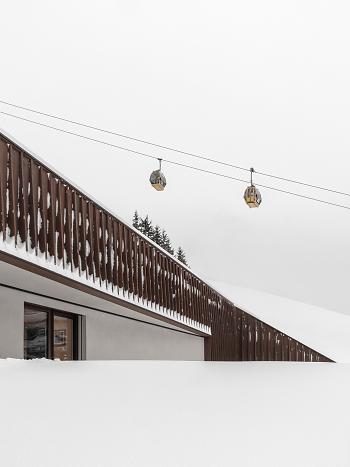
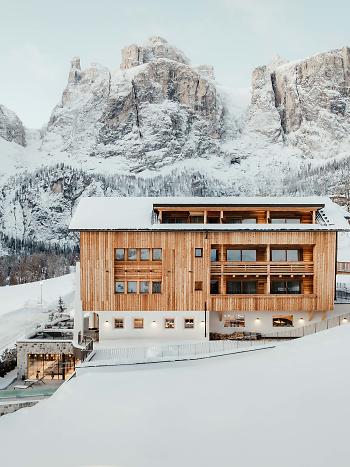
A landscape in transformation
However, the strong growth of tourism over the years has greatly modified the appearance of the surrounding landscape. Today, this theme is addressed with greater awareness. "Hotel construction is now mostly qualitative, following local planning guidelines," observes Emanuel Kostner, describing an evolution of hospitality offerings that aims for the improvement of standards and the search for forms of hospitality capable of valorising the territory's specificities while reducing its impact on the environmental context.
And precisely this capacity for listening to context and the choice – which today may seem counter-current – to remain in the territory of one's origins, making this rootedness not a limitation but a richness, unites the three studios. Their perspective is that of those who know places intimately while remaining open to the transformations that today's reality demands, in a delicate balance between belonging and renewal. Their approach finds deep roots in that research tradition that has characterised South Tyrol for decades, where daily confrontation with the complexity of the Alpine landscape has led architects to a method based on listening and sensitivity, of patience and determination.
This is not experimentation for its own sake, but a consolidated way of understanding architecture that finds in Alta Badia a particularly stimulating field of application due to the richness of its cultural and landscape stratifications. Their choice to operate in the valley is a testament to their capacity to consider the new as the continuation of the existing and not as the ruin of tradition – which more generally characterizes South Tyrolean architecture. Their work produces specific features, attentive to the peculiarities of a territory where tourism has assumed unique dimensions and characteristics.
Their work demonstrates that it is possible to construct a present that is simultaneously respectful of the past and open to change, always maintaining listening to context and enhacing those local competencies that represent an irreplaceable heritage. An approach that continues to evolve, finding in these Alpine valleys fertile ground for its maturation.
Architect, editor and curator Dr. Simona Galateo studied in Ferrara, Brighton and received her PhD at Milan’s Politecnico. She has edited books, written for Abitare, Domus and Arquitectura Viva, and has curated major exhibitions, including those held at the Venice Biennale and Milan Triennale. She is also a Turris Babel editor and research fellow at the Free University of Bozen-Bolzano

Where every scene becomes a memory and every memory a lasting connection to the mountains.
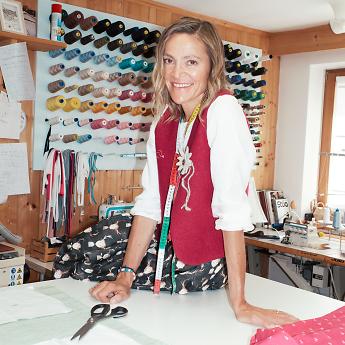
Intervista con Anita Vittur, stilista, sarta di abiti tradizionali, maestra di sci e spirito libero





































